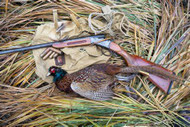Mastering Pheasant Hunting: Finding the Perfect Shot for Your 20-Gauge Shotgun
Posted by Eagle Armorment on Apr 10th 2024
Mastering Pheasant Hunting: Finding the Perfect Shot for Your 20-Gauge Shotgun
Looking to up your game in pheasant hunting? If you're wielding a 20-gauge shotgun, you've come to the right place. In this article, we'll reveal the secrets to finding the perfect shot when targeting pheasants.
Whether you're a seasoned hunter or just starting out, having the right techniques and strategies can significantly improve your success rate. Pheasant hunting requires precision, patience, and a keen eye for detail. By mastering the art of shooting with a 20-gauge shotgun, you'll be able to take down those elusive birds with ease.
Throughout this guide, we'll cover essential aspects such as selecting the right ammunition, understanding proper shooting techniques, and employing effective field strategies. We'll also delve into the role of choke selection and discuss how to ensure a humane shot.
With our expert tips and advice, you'll gain the confidence needed to enhance your pheasant hunting skills and optimize your shotgun performance. So, gear up and prepare for a thrilling hunting experience like no other. Get ready to make the perfect shot with your 20-gauge shotgun!
Understanding the 20-gauge shotgun
The 20-gauge shotgun is a popular choice among hunters due to its versatility and manageable recoil. It strikes the perfect balance between power and maneuverability, making it an excellent option for pheasant hunting. The gauge refers to the diameter of the shotgun bore, with the lower number indicating a larger barrel diameter.
Compared to its larger counterparts like the 12-gauge shotgun, the 20-gauge offers a lighter and more compact design, allowing for easier handling and quicker target acquisition. Its reduced recoil makes it a suitable choice for shooters of all experience levels, ensuring better accuracy and follow-up shots.
When using a 20-gauge shotgun for pheasant hunting, it's essential to understand its effective range. As a general rule of thumb, this gauge is effective up to 35 to 40 yards, making it ideal for close to mid-range shots commonly encountered in pheasant hunting scenarios. By familiarizing yourself with the capabilities of your firearm, you can maximize its potential in the field.
Choosing the right ammunition for pheasant hunting
Selecting the appropriate ammunition is crucial for successful pheasant hunting with a 20-gauge shotgun. The type of ammunition you choose can significantly impact the effectiveness of your shots and the overall hunting experience. When it comes to pheasant hunting, the two most commonly used types of ammunition are lead and steel shot.
Lead shot has long been the traditional choice for pheasant hunting due to its superior ballistic performance and denser pattern. However, many areas have banned the use of lead shot due to its potential environmental impact. In such cases, steel shot is the preferred alternative.
Steel shot has come a long way in terms of performance and is now available in various shot sizes and loads specifically designed for pheasant hunting. It offers good penetration and is effective within the effective range of a 20-gauge shotgun. When selecting steel shot, it's essential to choose a size that provides sufficient knockdown power without excessive pellet deformation.
Before heading out for your pheasant hunt, it's crucial to check local regulations and restrictions to ensure you're using the appropriate ammunition for your specific hunting area.
Proper gun handling and safety measures
Gun safety should always be a top priority when participating in any shooting activity, including pheasant hunting. Proper gun handling not only ensures your safety and the safety of those around you but also contributes to accurate and effective shooting.
First and foremost, familiarize yourself with your 20-gauge shotgun. Understand its components, including the safety mechanism, trigger, and loading and unloading procedures. Practice safe firearm handling by always treating the firearm as if it were loaded, keeping the muzzle pointed in a safe direction, and finger off the trigger until ready to shoot.
Additionally, wearing appropriate safety gear, such as eye and ear protection, is essential for a safe and enjoyable hunting experience. Make sure to wear blaze orange or other highly visible clothing to remain visible to other hunters in the area.
Lastly, always be aware of your surroundings and follow proper hunting etiquette. Communicate with fellow hunters in your group, establish safe zones of fire, and never shoot at low-flying birds. By adhering to these safety measures, you can minimize the risk of accidents and ensure a safe and enjoyable pheasant hunting experience.
Finding the ideal shot placement for pheasants
Shot placement is crucial for ethical hunting and quick, humane kills. Pheasants have a relatively small vital area, making shot placement even more critical. When targeting pheasants with a 20-gauge shotgun, it's important to aim for the head or neck area for a clean kill.
The head and neck offer a higher concentration of vital organs, such as the brain and spinal cord, which are essential for an immediate and humane kill. By targeting these areas, you increase the likelihood of a quick and clean kill while minimizing the risk of wounding the bird.
When taking a shot, it's important to consider the bird's flight pattern and angle. For birds flying directly away from you, aim slightly above the head to compensate for the angle and ensure proper shot placement. Similarly, for birds flying towards you, aim slightly below the neck area to account for the angle and achieve optimal shot placement.
Practicing proper shot placement is crucial for ethical hunting and ensures a quick and humane kill, minimizing the suffering of the bird.
Practicing shooting techniques for pheasant hunting
To master the art of shooting with a 20-gauge shotgun, regular practice is essential. By honing your shooting techniques, you can improve accuracy, consistency, and overall performance in the field. Here are a few key shooting techniques to focus on:
- Mounting and shouldering: Properly mounting and shouldering your shotgun is the foundation for accurate shooting. Practice shouldering your shotgun smoothly and consistently to establish a solid shooting position.
- Sight alignment and picture: Develop proper sight alignment and picture by aligning the shotgun's front sight with the target and maintaining focus on the target while keeping the rear sight in your peripheral vision.
- Follow-through: Follow-through is crucial for maintaining accuracy. After pulling the trigger, continue the swing and maintain your focus on the target until the bird is down. This helps ensure proper shot placement and prevents stopping the gun prematurely.
Regular practice at a shooting range or clay pigeon course can significantly improve your shooting skills. It allows you to develop muscle memory, refine your technique, and build confidence in your shooting abilities. Additionally, consider practicing shooting from various shooting positions, such as standing, kneeling, and shooting from a blind, to prepare for different hunting scenarios.
Essential gear and equipment for a successful hunt
Having the right gear and equipment is essential for a successful pheasant hunting trip. Here's a list of essential items to consider:
- Shotgun: Opt for a reliable 20-gauge shotgun suitable for pheasant hunting. Ensure it's properly cleaned, maintained, and zeroed before heading out.
- Ammunition: Choose the appropriate ammunition for pheasant hunting, considering local regulations and restrictions.
- Chokes: Utilize chokes that are suitable for pheasant hunting. Chokes can help tighten or widen the shotgun's shot pattern, depending on the hunting conditions and shooting distance.
- Blaze orange clothing: Wear blaze orange or other highly visible clothing to remain visible to other hunters.
- Hunting vest: A hunting vest with ample storage pockets allows you to carry necessary items such as extra ammunition, water, snacks, and game bags.
- Binoculars: Binoculars can help you spot birds from a distance and plan your approach accordingly.
- Field dressing kit: Carry a field dressing kit for cleaning and preparing harvested birds in the field.
By ensuring you have the right gear and equipment, you'll be well-prepared for a successful pheasant hunting adventure.
Tips for scouting and locating pheasants
Scouting and locating pheasants are essential steps in increasing your chances of a successful hunt. Here are some tips to help you find these elusive birds:
- Research: Study maps, talk to local hunters, and gather information about the hunting area. Look for areas with suitable habitat, such as fields, grasslands, and brushy areas, where pheasants are likely to be found.
- Early morning and late afternoon: Pheasants are most active during early morning and late afternoon, so plan your hunts accordingly. Be in the field before sunrise to catch birds as they leave their roosts and focus on hunting during the last few hours of daylight.
- Listen for calls: Pheasants often make distinct calls, especially during the breeding season. Listen for their cackling and crowing sounds, which can help you locate their general vicinity.
- Look for signs: Pheasants leave behind signs that can indicate their presence. Look for tracks, feathers, dusting areas, and droppings to identify potential hotspots.
- Utilize hunting dogs: Well-trained hunting dogs can be invaluable in locating and flushing out pheasants. Consider utilizing a trained retriever or flushing dog to assist in your hunting efforts.
Scouting and locating pheasants can be a time-consuming process, but the rewards are well worth the effort. By putting in the time to scout and gather information, you can significantly increase your chances of encountering pheasants during your hunts.
Strategies for approaching and flushing out pheasants
Approaching and flushing out pheasants require careful planning and execution. Successfully maneuvering through the field and getting close to the birds without alerting them can be challenging. Here are some effective strategies to consider:
- Utilize natural cover: Take advantage of natural cover, such as tall grass, brush, and fence lines, to approach pheasants undetected. Move slowly and quietly, using the cover as a shield to conceal your presence.
- Coordinate with hunting partners: If hunting in a group, establish a coordinated approach to maximize efficiency. Assign specific roles, such as blockers and walkers, to strategically flush out birds.
- Flushing techniques: When flushing pheasants, it's important to flush them in a controlled manner to ensure safer shots. Walk towards the birds, allowing them to run ahead of you before taking off. This minimizes the risk of low-flying birds and provides safer shooting opportunities.
- Use hunting dogs: A well-trained hunting dog can be instrumental in flushing out pheasants. Work with your dog to establish effective communication and utilize their natural instincts to locate and flush birds.
Remember, safety should always be a priority when approaching and flushing out pheasants. Maintain proper spacing between hunters, establish safe zones of fire, and communicate effectively to avoid any accidents.
Conclusion and final thoughts
Mastering pheasant hunting with a 20-gauge shotgun requires a combination of proper techniques, suitable equipment, and field strategies. By understanding your shotgun, selecting the right ammunition, practicing your shooting skills, and employing effective hunting strategies, you can enhance your pheasant hunting experience and increase your chances of success.
Remember to prioritize safety at all times, follow local regulations, and practice ethical hunting practices. Pheasant hunting is not just about bagging a bird; it's about immersing yourself in nature, testing your skills, and enjoying the camaraderie of fellow hunters.
So, gear up, put these tips into practice, and embark on an unforgettable pheasant hunting adventure with your trusty 20-gauge shotgun. With dedication, practice, and a little bit of luck, you'll be well on your way to becoming a skilled pheasant hunter. Happy hunting!



